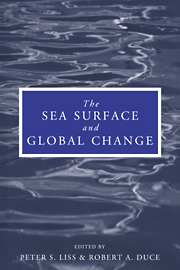Book contents
- Frontmatter
- Contents
- List of contributors
- Preface
- 1 Report Group 1 – Physical processes in the microlayer and the air–sea exchange of trace gases
- 2 Report Group 2 – Biological effects of chemical and radiative change in the sea surface
- 3 Report Group 3 – Photochemistry in the sea-surface microlayer
- 4 Transport processes in the sea-surface microlayer
- 5 The role of organic films in air–sea gas exchange
- 6 Bubbles and their role in gas exchange
- 7 The physical chemistry of air–sea gas exchange
- 8 The sea-surface microlayer and its effect on global air–sea gas transfer
- 9 Chemistry of the sea-surface microlayer
- 10 Biophysics of the surface film of aquatic ecosystems
- 11 Biological effects of chemicals in the sea-surface microlayer
- 12 Neuston of seas and oceans
- 13 Photochemistry in the sea-surface microlayer
- 14 Hydrocarbon breakdown in the sea-surface microlayer
- 15 Applications of laser technology and laser spectroscopy in studies of the ocean microlayer
- 16 Remote sensing of the sea-surface microlayer
- Index
15 - Applications of laser technology and laser spectroscopy in studies of the ocean microlayer
Published online by Cambridge University Press: 24 September 2009
- Frontmatter
- Contents
- List of contributors
- Preface
- 1 Report Group 1 – Physical processes in the microlayer and the air–sea exchange of trace gases
- 2 Report Group 2 – Biological effects of chemical and radiative change in the sea surface
- 3 Report Group 3 – Photochemistry in the sea-surface microlayer
- 4 Transport processes in the sea-surface microlayer
- 5 The role of organic films in air–sea gas exchange
- 6 Bubbles and their role in gas exchange
- 7 The physical chemistry of air–sea gas exchange
- 8 The sea-surface microlayer and its effect on global air–sea gas transfer
- 9 Chemistry of the sea-surface microlayer
- 10 Biophysics of the surface film of aquatic ecosystems
- 11 Biological effects of chemicals in the sea-surface microlayer
- 12 Neuston of seas and oceans
- 13 Photochemistry in the sea-surface microlayer
- 14 Hydrocarbon breakdown in the sea-surface microlayer
- 15 Applications of laser technology and laser spectroscopy in studies of the ocean microlayer
- 16 Remote sensing of the sea-surface microlayer
- Index
Summary
Abstract
Laser spectroscopy and laser probes now provide previously unobtainable information on the physico-chemical structure and processes of the ocean microlayer. Methods range from laboratory techniques to in situ ocean microlayer probes.
In the laboratory, laser-induced fluorescence from water-soluble dye molecules is used to track aqueous layer interfacial movement. With these techniques, researchers infer turbulence in the upper several millimetres of a water surface. It is also possible to measure timescales of interfacial layer concentration fluctuations and interfacial layer penetration depths thus providing estimates of gas transfer velocities. Laser induced fluorescence methods are presently limited to laboratory studies.
Two-dimensional scanning laser slope gauges provide in situ measurement of ocean slope. Ocean slope is measured from the refraction of a vertical laser beam upon passing from the ocean into the air. By rapid scanning of the laser beam through a geometric pattern on the ocean surface, the researcher determines ocean wave slope at a variety of surface positions. This measurement is performed on a timescale during which the ocean surface is essentially frozen in time. From the set of slopes, an estimate is obtained of the two-dimensional capillary–gravity wave spectrum for a given instant of time and a given region of ocean surface.
Nonlinear spectroscopic processes such as reflected second harmonic generation and reflected sum frequency generation provide non-intrusive in situ spectroscopic probes of the ocean surface.
- Type
- Chapter
- Information
- The Sea Surface and Global Change , pp. 445 - 470Publisher: Cambridge University PressPrint publication year: 1997
- 3
- Cited by



